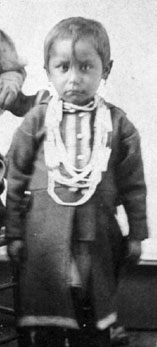|
Purpose |
|
The intent of the U.S. Indian policy was to discourage
the Kaws from hunting buffalo and trapping, and to encourage them to
adopt a sedentary life devoted to agriculture. For twenty years prior to
the construction of the Kaw Mission, the government had sought to direct
the Kaws into a way of life that would be more acceptable to white
culture.
 |
One means of effecting this cultural transition was
to educate the Kaw children. Through schooling, Kaw
children could be molded into accepting white ways. As
adults, these educated Indians would become the leaders
of the Kaw tribe and pave the way for their people to
give up their traditional hunting and religious
practices and become Christian farmers.
|
|
| The agents for this cultural
transformation were to be Christian missionaries. Their
efforts among the
Kaws would be funded by the U.S.
government. The government derived its revenues by the
sale of Kaw
lands that the tribe had forfeited in the
Treaty of 1825.
In 1830, the Missouri Conference of the Methodist
Episcopal Church organized an Indian Missionary Society.
Reverend Thomas Johnson was appointed missionary
superintendent of the Shawnee Indians and his brother,
William, was appointed to the same position for the Kaws. William Johnson established a mission for the
Kaws near Mission Creek just west of present-day
Topeka. This mission met with little success.
|
| White Americans
had little appreciation for what problems would
accompany this attempt at imposing a cultural revolution
on the
Kaws.
Many American policy-makers believed that only a few
details remained to be worked out for this
transformation to be a success.
In fact, there were a number of deep-seated problems
that obstructed the missionaries’ progress in the
1830s and 1840s among the Kaws:
1) The semi-sedentary life of the Kaw
proved
resistant to attempts to change the culture.
2) There was a great deal of conflict among various Kaw
villages.
3) The Kaws lived in extreme poverty.
4) There were few reliable interpreters of the
Kaw language.
5) Indian agents were not enthusiastic about the
missionaries’ efforts.
|
|
Despite continuous setbacks,
the Methodists persisted in their efforts to sustain a
school among the Kaws at Mission Creek. However, the
Methodists became convinced that the only effective way
to change the Kaws was to remove
Kaw children from
their village environment to a boarding school. Efforts
were made, with limited success, to send Kaw
children
to the Shawnee Mission Manual Labor School near
present-day Kansas City.
|
 |
 |
When the Kaws
were relocated to the Neosho River Valley in 1848, the
government and the Methodists saw another opportunity to
pursue their education of Kaw children. In the winter
of 1850-51 the Methodists from the Shawnee Mission, with
government funding, constructed a boarding school on the
banks of the Neosho River in Council Grove. This was the
Kaw Mission.
|
|
|


